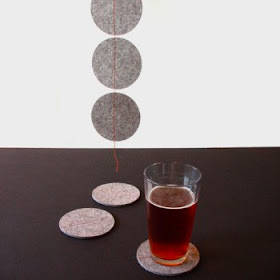Article taken off mnn.com
Let me entertain you: Coasters
Make your holiday fete feel a bit more special while protecting household surfaces — after a couple of boozy eggnogs, party guests are liable to put their drinks anywhere — with Eco-friendly beverage coasters.

A very happy Monday-after-Thanksgiving and welcome to the third installment of "Let me entertain you," a new series of weekly posts that I’ll be running throughout this epically festive — and epically food-heavy — time of year. The topic? Holiday entertaining and the paraphernalia needed to make your gathering — whether it’s a traditional Turkey Day dinner with the extended family, a booze-heavy winter solstice shindig, or an intimate Christmahanakwanzaka brunch amongst friends — go off without a hitch. Naturally, the emphasis is on products that boast one or all of the following Eco-friendly attributes: a. handmade b. made from sustainable or recycled materials c. domestically manufactured or d. durable/made-to-last so in that they’ll be used not just this holiday season for many more seasons to come.
To complement last week's post on mess-minimizing reusable placemats and napkins, today I've wrangled up a few eye-catching coasters to help make cocktail-heavy holiday soirees a touch more civilized and add a bit of protective texture to household surfaces. Because really, there's nothing more frustrating than cleaning up the morning after to find eggnog rings gracing every single flat surface in your home. And while we're on the topic of libations ('tis the season!), be sure to check in next Monday as I'll be featuring wine and cocktail accoutrement.
Felt Coasters by Josh Jakus @ Branch ($18/string of 6)

Banded Wood Coasters by Pigeon Toe Ceramics @ Supermarket ($96/set of 4)

Toast It Coasters @ Paper Source ($11.95)

Recycled Glass Wine Coaster @ Terrain ($10)

Ferm Living Cork Coaster @ Velocity Art & Design ($21.95)

Bamboo Coasters @ Branch ($16/set of 4)

Newspaper Coasters @ MoMa Store ($10)

Hickory Coaster Set @ Terrain ($22)

Recycled Holiday Record Coasters @ Uncommon Goods ($22/set of 6)

Slate Beverage Coaster @ Brooklyn Slate Co. ($22/set of 4)

Sprig Recycled Leather Coaster by Shara Porter @ Supermarket ($6)







































